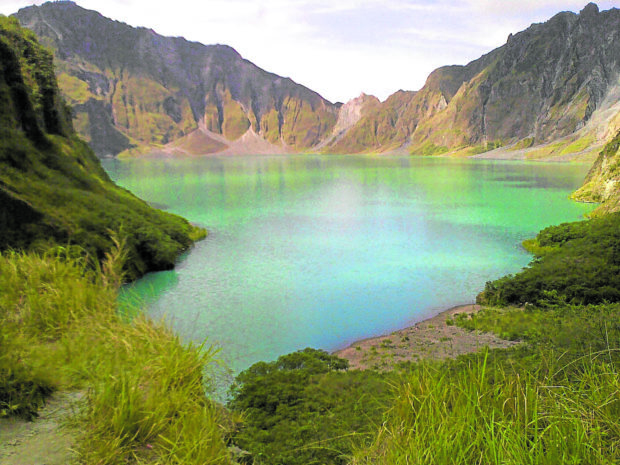
FILE PHOTO: The serenity offered by the crater lake formed after Mt. Pinatubo’s eruption in 1991 calms weary visitors. Treks to Pinatubo, however, are discouraged after government volcanologists raised the alert level on the volcano. —TONETTE OREJAS
MABALACAT CITY, Pampanga — At least 42 volcanic earthquakes were recorded around Mt. Pinatubo on Monday alone, prompting the Philippine Institute of Volcanology and Seismology (Phivolcs) to keep its warning against entering the crater area that has become a tourist attraction.
In its May 17 bulletin, Phivolcs noted that the number of tremors in the area was a significant increase from the earthquakes recorded daily since May 10.
The second highest record of earthquakes in the past week was on May 14 with 19. On May 11, only a single tremor was registered in the area.
Phivolcs said alert level 1 (abnormal) remained hoisted over the area. This means there was still no imminent eruption and the low-level unrest may be related to “tectonic processes beneath its edifice.”
The alert level 1 was raised from zero (calm) on March 4 due to the series of earthquakes in the area. It was the first time that Phivolcs raised the warning status in Mt. Pinatubo since 1996 when it was placed on normal status.
“Communities and local government units surrounding Pinatubo are reminded to be always prepared for both earthquake and volcanic hazards…,” Phivolcs said.
The agency said it was continuously monitoring the condition of the volcano.
Mt. Pinatubo straddles the provinces of Pampanga, Tarlac and Zambales.
‘Imperceptible’
In January, the Phivolcs issued a Pinatubo advisory after detecting 826 “imperceptible” or “not easily noticed earthquakes” east-northeast of the volcano since January 20.
The quakes ranged between magnitude 1 and 2.5 at depths of 15 to 28 kilometers, it said
Despite the earthquakes, the agency still placed Pinatubo on alert level zero at that time, saying the volcano remained in dormant condition and that that there was no threat from the earthquake activities.
Pinatubo’s eruption on June 15, 1991, was historically considered the second-largest volcanic eruption of the 20th Century.
The United States Geological Survey (USGS) said Pinatubo’s eruption “produced high-speed avalanches of hot ash and gas, giant mudflows, and a cloud of volcanic ash hundreds of miles across.”
According to the USGS, the cataclysmic eruption injected nearly 20 million tons of sulfur dioxide into the stratosphere (second layer of Earth’s atmosphere) that caused global temperature to drop temporarily by 0.5 degree Celsius from 1991 to 1993. INQ